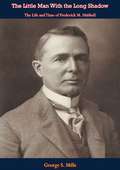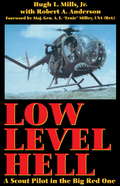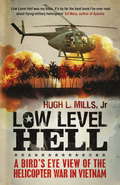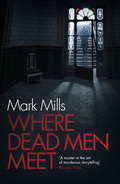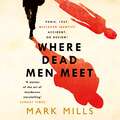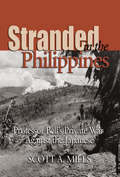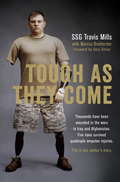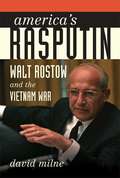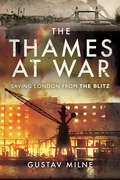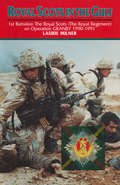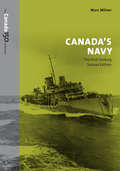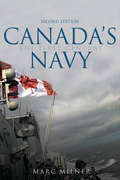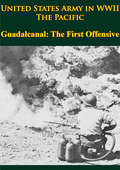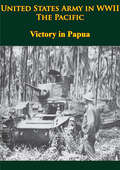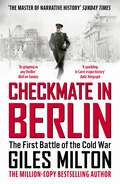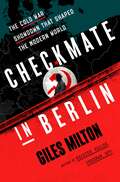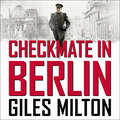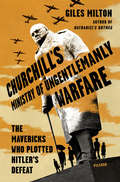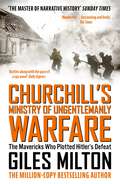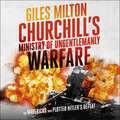- Table View
- List View
The Little Man With the Long Shadow: The Life and Time of Frederick M. Hubbell (Bur Oak Book Ser.)
by George S. MillsFrederick M. Hubbell, railroad financier and builder, real estate investor, public utilities magnate, leading lawyer, and founder of Iowa’s first life insurance company, the Equitable, was at one time the wealthiest Iowan in the state’s history. Based on his diaries from 1855 to 1927, The Little Man with the Long Shadow tells the story of this industrious and imaginative entrepreneur.
Low Level Hell: A Scout Pilot in the Big Red One
by Hugh MillsThe aeroscouts of the 1st Infrantry Division had three words emblazoned on their unit patch: Low Level Hell. This was the perfect definition of what these pilots experienced as the ranged the skies of Vietnam. Mills tells the combat experiences of these aviators.
Low Level Hell: A Scout Pilot In The Big Red One
by Hugh Mills Robert Anderson'The best 'bird's eye view' of the helicopter war in Vietnam in print today ... Mills has captured the realities of a select group of aviators who shot craps with death on every mission' R.S. Maxham, Director, US Army Aviation MuseumThe aeroscouts of the 1st Infantry Division have three words emblazoned on their unit patch: Low Level Hell. It was the perfect concise defininition of what those intrepid aviators experienced as they ranged the skies of Vietnam from the Cambodian border to the Iron Triangle. The Outcasts, as they were known, flew low and slow. They were the aerial eyes of the division in search of the enemy. Too often for longevity's sake they found the Viet Cong and the fight was on. These young pilots, who were usually 19 to 22 years old, invented the book as they went along.
All I Ever Wanted (The Summer Love Novels #1)
by Katrina MillsIn this romantic comedy, the reunion between a teacher and her army veteran ex-love might make for the hottest summer this small town has ever seen. Eat a stick of butter or return to her hometown? School teacher Kinsley Bailey would rather risk the caloric overload. Staunton, Virginia, is laced in bad memories of a mentally ill mother, an estranged father, and the first boy who broke her heart. Yet the news of her father&’s death has forced her return to the nightmare. Now in the heat of summer, Kinsley&’s left unraveling the mysteries surrounding a house, an antique gun collection, a flabby basset hound, and a safety deposit box that no one in the family wants to discuss. After a series of tough breaks, army soldier Bastian Harris desires the serenity of small town life in Staunton. Even with women signing up for his shooting courses and emphasizing their desires for a different kind of target practice, he keeps his nose down and his gun in his holster. Yet when a certain auburn-haired blast from the past comes blazing into his shop to sell her late father&’s antique gun collection, he might have to reconsider the tranquil life and take up arms for the one woman he could never forget.
Where Dead Men Meet: The adventure thriller of the year
by Mark MillsA return to the period adventure thriller in WHERE DEAD MEN MEET re-establishes Mark Mills as:'A master storyteller' Val McDermid. For fans of William Boyd, Charles Cumming or Robert HarrisParis, 1937. Luke Hamilton - a junior air intelligence officer at the British Embassy - finds himself the target of an assassination attempt. A clear case of mistaken identity, or so it first appears. As Luke is hunted across a continent sliding towards war, he comes to learn that the answers lie deep in a past that predates his abandonment as a baby on the steps of an orphanage twenty-five years ago.From the author of the bestselling THE SAVAGE GARDEN, and set against a terrific backdrop of Europe on the cusp of the Second World War, this is a compelling novel, rich in adventure, espionage, secrets and lies.
Where Dead Men Meet: The adventure thriller of the year
by Mark MillsA return to the period adventure thriller in WHERE DEAD MEN MEET re-establishes Mark Mills as:'A master storyteller' Val McDermid. For fans of William Boyd, Charles Cumming or Robert HarrisParis, 1937. Luke Hamilton - a junior air intelligence officer at the British Embassy - finds himself the target of an assassination attempt. A clear case of mistaken identity, or so it first appears. As Luke is hunted across a continent sliding towards war, he comes to learn that the answers lie deep in a past that predates his abandonment as a baby on the steps of an orphanage twenty-five years ago.From the author of the bestselling THE SAVAGE GARDEN, and set against a terrific backdrop of Europe on the cusp of the Second World War, this is compelling novel, rich in adventure, espionage, secrets and lies.(P)2016 Headline Digital
A Common Operating Picture for Air Force Materiel Sustainment
by Patrick Mills Don Snyder Raymond A. Pyles Robert S. Tripp Kristin F. LynchDescribes a potential common operating system (COP) for the Air Force materiel sustainment system (MSS). The authors first develop a COP based on the principles of effects-based measures, schwerpunkt (organizational focus), decision rights, and a nonmarket economic framework, then they apply the COP to depot-level reparable component sustainment to illustrate how the COP would improve overall MSS efficiency and responsiveness.
Stranded in the Philippines
by Scott A. MillsAmerican missionaries Henry Roy Bell and his wife Edna had been teaching in the Philippines at Silliman University for twenty years when the Japanese invaded the islands after the attack on Pearl Harbor. This is the story of their guerilla war against the Japanese, from the time they took to the hills until they were secretly evacuated by submarine three years later. At first willing only to provide food to the young men covertly fighting against the Japanese, Bell eventually became fully involved in the Filipino resistance movement and rose to the rank of major in an island-wide guerrilla army. With a price on his head and his capture eminent, Bell, his wife, and two teenage sons were smuggled across the island and, on February 6, 1944, escaped on board a cargo submarine delivering arms and ammunition to the guerrillas
Tough As They Come
by Travis Mills Marcus Brotherton Gary SiniseThousands have been wounded in the wars in Iraq and Afghanistan. Five have survived quadruple amputee injuries. This is one soldier's story. Thousands of soldiers die year to defend their country. United States Army Staff Sergeant Travis Mills was sure that he would become another statistic when, during his third tour of duty in Afghanistan, he was caught in an IED blast four days before his twenty-fifth birthday. Against the odds, he lived, but at a severe cost--Travis became one of only five soldiers from the wars in Afghanistan and Iraq to survive a quadruple amputation. Suddenly forced to reconcile with the fact that he no longer had arms or legs, Travis was faced with a future drastically different from the one he had imagined for himself. He would never again be able to lead his squad, stroke his fingers against his wife's cheek, or pick up his infant daughter. Travis struggled through the painful and anxious days of rehabilitation so that he could regain the strength to live his life to the fullest. With enormous willpower and endurance, the unconditional love of his family, and a generous amount of faith, Travis shocked everyone with his remarkable recovery. Even without limbs, he still swims, dances with his wife, rides mountain bikes, and drives his daughter to school. Travis inspires thousands every day with his remarkable journey. He doesn't want to be thought of as wounded. "I'm just a man with scars," he says, "living life to the fullest and best I know how."From the Hardcover edition.
Tough As They Come
by Travis Mills Marcus Brotherton Gary SiniseThousands have been wounded in the wars in Iraq and Afghanistan. Five have survived quadruple amputee injuries. This is one soldier's story. Thousands of soldiers die year to defend their country. United States Army Staff Sergeant Travis Mills was sure that he would become another statistic when, during his third tour of duty in Afghanistan, he was caught in an IED blast four days before his twenty-fifth birthday. Against the odds, he lived, but at a severe cost--Travis became one of only five soldiers from the wars in Afghanistan and Iraq to survive a quadruple amputation. Suddenly forced to reconcile with the fact that he no longer had arms or legs, Travis was faced with a future drastically different from the one he had imagined for himself. He would never again be able to lead his squad, stroke his fingers against his wife's cheek, or pick up his infant daughter. Travis struggled through the painful and anxious days of rehabilitation so that he could regain the strength to live his life to the fullest. With enormous willpower and endurance, the unconditional love of his family, and a generous amount of faith, Travis shocked everyone with his remarkable recovery. Even without limbs, he still swims, dances with his wife, rides mountain bikes, and drives his daughter to school. Travis inspires thousands every day with his remarkable journey. He doesn't want to be thought of as wounded. "I'm just a man with scars," he says, "living life to the fullest and best I know how."From the Hardcover edition.
Historic Houses of New Jersey: [Illustrated Edition]
by W. Jay MillsOne of the standard works on notable early houses in the state.“UNTIL now the State possessing the most inexhaustible supply of colonial, Revolutionary, and republican souvenirs has been almost neglected. Indeed, few of the original thirteen States can be compared with New Jersey in the number and importance of its landmarks. Her society, too, was as intellectual as that which sprang from the rocks of Puritanism, and it formed a brilliant pageant, rivalling the glittering line of the cavaliers. There is scarcely an acre of soil in the northern part of the State not once pressed by the foot of the Revolutionary soldier, and there are few of the many hundreds of dwellings which have survived the march of a century that did not shelter at one time or another some of the heroes of ‘76, or the colonial dames and daughters who played scarcely less potent parts in the drama of our struggle for freedom. This is the only book to tell the true story of the old houses of New Jersey, and such a record possesses deep significance for every American, as it has much more than a local or State interest.Of the glowing and passionate pictures of early days little more than the frames and the sentiment lingering about them now remain. It has been the author’s pleasure to fill in the frames with the portraits and the scenes that history and tradition, as contained in family recollection, in unpublished letters, and in local records suggest. Anecdote and gossip have supplied him with many a side-light on the great figures and their stirring times, and their chronicler will be satisfied if his story shall make more real the facts with which fancy delights to play.”
I Dream Of The Day - Letters From Caleb Milne - Africa, 1942-1943 [Illustrated Edition]
by Caleb MilneIncludes the War in North Africa Illustration Pack - 112 photos/illustrations and 21 maps.These are the letters Caleb Milne wrote to his mother while in the American Field Service.In May of 1943, he, with a small group of American Field Service men, responded to a call for volunteers to help the French. These Fighting French, under General Leclerc, had joined General Montgomery's 8th Army after that epic march from Lake Chad in Central Africa to Tunisia. Early the morning of May 11th, Caleb Milne was giving aid to a wounded Legionnaire when he was struck by a mortar shell. His wounds proved fatal and he died around 4:30 that afternoon.These letters, though very personal, are published with the thought that their message might reach beyond one mother. As Marjorie Kinnan Rawlings has said in her introduction:"This collection of his letters seems to me of permanent value, far beyond their satisfying of our avidity for news of the working of the minds of men who are fighting, for us, our battle. They reveal a rare soul, who passes on to us his own sensitive perceptions of the beauty and glory of living; and they are written in the style of true Belles-Lettres."In tribute to Caleb Milne, who wrote to him on the meaning of music to a soldier, Deems Taylor, noted author and composer, said:"This, to me, is one of the most deeply felt and profoundly moving communications that the war has yet inspired. It is one of the war's major tragedies that young men capable of such vision, self-abnegation, and compassion could not be spared to help shape the peace that, God willing, will be as nearly permanent as men of good will can make it."
America's Rasputin: Walt Rostow and the Vietnam War
by David MilneWalt Rostow's meteoric rise to power -- from Flatbush, Brooklyn, to the West Wing of the White House -- seemed to capture the promise of the American dream. Hailing from humble origins, Rostow became an intellectual powerhouse: a professor of economic history at MIT and an influential foreign policy adviser to John F. Kennedy and Lyndon B. Johnson. Too influential, according to some. While Rostow inspired respect and affection, he also made some powerful enemies. Averell Harriman, one of America's most celebrated diplomats, described Rostow as "America's Rasputin" for the unsavory influence he exerted on presidential decision-making. Rostow was the first to advise Kennedy to send U.S. combat troops to South Vietnam and the first to recommend the bombing of North Vietnam. He framed a policy of military escalation, championed recklessly optimistic reporting, and then advised LBJ against pursuing a compromise peace with North Vietnam. David Milne examines one man's impact on the United States' worst-ever military defeat. It is a portrait of good intentions and fatal misjudgments. A true ideologue, Rostow believed that it is beholden upon the United States to democratize other nations and do "good," no matter what the cost. America's Rasputin explores the consequences of this idealistic but unyielding dogma.
The Thames at War: Saving London From the Blitz
by Gustav MilneThis illustrated WWII history pays tribute to the engineers and emergency repair teams who saved London from flooding during the relentless air raids.Between 1940 and 1945 London suffered persistent Nazi air raids, bringing widespread destruction both day and night. Meanwhile, there lurked another devastating threat: the possibility of widespread flooding if the Nazi onslaught ever breached the Thames’ river defenses. The Thames at War sheds light on the vital role of the London County Council emergency repair teams and the unsung achievements of their leader, Chief Engineer Thomas Peirson Frank, who time and again saved the capital from drowning. Historian Gustav Milne also explores the fate of London’s docks and bridges, as well as the ships, boats and barges lost in the estuary and tideway.
Royal Scots In The Gulf: 1st Battalion The Royal Scots (The Royal Regiment) on Operation GRANBY 1990-1991
by Laurie MilnerInsight into the unique atmosphere of a Scottish battalion during combat—taking part in the Iraqi ground war facing many unknown and unknowable factors. The brevity of the ground war in the Gulf is well known, just 100 hours. By the end of the war, press reports of the massive numbers of Iraqi prisoners taken, and equipment destroyed, compared to our own losses, suggested that it was a walkover. In hindsight it would seem so; however, the experts&’, not to mention the media&’s, estimates of the Iraqi&’s strength and capabilities, and the wild predictions of heavy casualties, are decidedly at odds with the outcome. This book tries to answer why. In telling the story of The Royal Scots Battle Group, Laurie Milner reveals the remarkable single-mindedness and courage of the soldiers of Britain&’s present-day Army in the face of a numerically superior, well-equipped and well dug-in enemy, whose level of resistance could not be accurately assessed. While the pundits in Britain were judging our Army&’s likely performance on the peacetime training expediencies of BAOR, The Royal Scots, Britain&’s oldest infantry regiment, were carefully preparing their vehicles, weapons, and soldiers for war. The extent of their final preparations and potential is chilling. It is little wonder that they won, for they left nothing to chance.
Canada's Navy, 2nd Edition: The First Century
by Marc MilnerFrom its eighteenth-century roots in exploration and trade, to the major conflicts of the First and Second World Wars, through to current roles in multinational operations with United Nations and NATO forces, Canada's navy - now celebrating its one hundredth anniversary - has been an expression of Canadian nationhood and a catalyst in the complex process of national unity.In the second edition of Canada's Navy, Marc Milner brings his classic work up to date and looks back at one hundred years of the Navy in Canada. With supplementary photos, updated sources, a new preface and epilogue, and an additional chapter on the Navy's global reach from 1991 to 2010, this edition carries Canadian Naval history into the twenty-first century. Milner brings effortless prose and exacting attention to detail to his comprehensive and accessible examination of this fascinating Canadian organization. This much-needed update of Canada's Navy will continue to provoke discussion about the past and future of the country's naval forces and their evolving role in the interwoven issues of maritime politics and economics, defence and strategy, and national and foreign policy.
Canada's Navy, 2nd Edition: The First Century
by Marc MilnerFrom its eighteenth-century roots in exploration and trade, to the major conflicts of the First and Second World Wars, through to current roles in multinational operations with United Nations and NATO forces, Canada's navy – now celebrating its one hundredth anniversary – has been an expression of Canadian nationhood and a catalyst in the complex process of national unity. In the second edition of Canada’s Navy, Marc Milner brings his classic work up to date and looks back at one hundred years of the navy in Canada. With supplementary photographs, updated sources, a new preface and epilogue, and an additional chapter on the navy’s global reach from 1991 to 2010, this edition carries Canadian naval history into the twenty-first century. Milner brings effortless prose and exacting detail to discussions about topics as diverse as Arctic sovereignty, fishing wars, and international piracy. Comprehensive and accessible, Canada’s Navy will continue to provoke discussion about the past and future of the country’s naval forces and their evolving role in the interwoven issues of maritime politics and economics, defence and strategy, and national and foreign policy.
United States Army In WWII - The Pacific - Guadalcanal: [Illustrated Edition] (United States Army in WWII)
by Samuel Milner[Includes 3 charts, 36 maps and 107 illustrations]"The successes of the South Pacific Force," wrote Admiral Halsey in 1944, "were not the achievements of separate services or individuals but the result of whole-hearted subordination of self-interest by all in order that one successful 'fighting team' could be created." The history of any South Pacific campaign must deal with this "fighting team," with all United States and Allied services. The victory on Guadalcanal can be understood only by an appreciation of the contribution of each service. No one service won the battle. The most decisive engagement of the campaign was the air and naval Battle of Guadalcanal in mid-November 1942, an engagement in which neither Army nor Marine Corps ground troops took any direct part.This volume attempts to show the contribution of all services to the first victory on the long road to Tokyo. It does not describe all ground, air, and naval operations in detail but it does attempt, by summary when necessary, to show the relationship between air, ground, and surface forces in modern warfare.
United States Army in WWII - the Pacific - Victory in Papua: [illustrated Edition] (United States Army In Wwii Ser.)
by Samuel Milner[Includes 23 maps and 95 illustrations]This is a companion volume to the one on Guadalcanal in the series on the war in the Pacific. Both record the operations designed to halt the advance of the enemy toward the vital transpacific line of communications with Australia and secure Australia as a base. Success in Papua and Guadalcanal, achieved in February 1943, put the Allied forces in a position to neutralize Rabaul and, this accomplished, to advance to the Philippines.The present volume concentrates on the action of one United States Army division. In telling the story of a comparatively limited number of troops, the author has been able to present the combat experience of small units in sharper focus than has been possible in most of the other full-scale campaign volumes.The campaign abounds in lessons.The strategic significance of the Papuan Campaign can be briefly stated. In addition to blunting the Japanese thrust toward Australia and the transpacific line of communications, it put General MacArthur's forces in a favorable position to take the offensive. But this little known campaign is significant for still another reason. It was the battle test of a large hitherto-inexperienced U. S. Army force and its commanders under the conditions which were to attend much of the ground fighting in the Pacific. Costly in casualties and suffering, it taught lessons that the Army had to learn if it was to cope with the Japanese under conditions of tropical warfare.
Checkmate in Berlin: The Cold War Showdown that Shaped the Modern World
by Giles Milton'Brilliantly recapturing the febrile atmosphere of Berlin in the first four years after the Second World War, Giles Milton reminds us what an excellent story-teller he is' - Andrew Roberts, author of Churchill: Walking with DestinyBerlin was in ruins when Soviet forces fought their way towards the Reichstag in the spring of 1945. Streets were choked with rubble, power supplies severed and the population close to starvation. The arrival of the Soviet army heralded yet greater terrors: the city's civilians were to suffer rape, looting and horrific violence. Worse still, they faced a future with neither certainty nor hope.Berlin's fate had been sealed four months earlier at the Yalta Conference. The city, along with the rest of Germany, was to be carved up between the victorious powers - British, American, French and Soviet. On paper, it seemed a pragmatic solution; in reality, it fired the starting gun for the Cold War. As soon as the four powers were no longer united by the common purpose of defeating Germany, they reverted to their pre-war hostility and suspicion. Rival systems, rival ideologies and rival personalities ensured that Berlin became an explosive battleground. The ruins of this once-great city were soon awash with spies, gangsters and black-marketeers, all of whom sought to profit from the disarray. For the next four years, a handful of charismatic but flawed individuals - British, American and Soviet - fought an intensely personal battle over the future of Germany, Europe and the entire free world.CHECKMATE IN BERLIN tells this exhilarating, high-stakes tale of grit, skullduggery, and raw power. From the high politics of Yalta to the desperate scramble to break the Soviet stranglehold of Berlin with the greatest aerial operation in history, this is the epic story of the first battle of the Cold War and how it shaped the modern world.
Checkmate in Berlin: The Cold War Showdown That Shaped the Modern World
by Giles MiltonFrom a master of popular history, the lively, immersive story of the race to seize Berlin in the aftermath of World War II as it’s never been told before BERLIN’S FATE WAS SEALED AT THE 1945 YALTA CONFERENCE: the city, along with the rest of Germany, was to be carved up among the victorious powers— the United States, Britain, France, and the Soviet Union. On paper, it seemed a pragmatic solution. In reality, once the four powers were no longer united by the common purpose of defeating Germany, they wasted little time reverting to their prewar hostility toward—and suspicion of—one another. The veneer of civility between the Western allies and the Soviets was to break down in spectacular fashion in Berlin. Rival systems, rival ideologies, and rival personalities ensured that the German capital became an explosive battleground.The warring leaders who ran Berlin’s four sectors were charismatic, mercurial men, and Giles Milton brings them all to rich and thrilling life here. We meet unforgettable individuals like America’s explosive Frank “Howlin’ Mad” Howley, a brusque sharp-tongued colonel with a relish for mischief and a loathing for all Russians. Appointed commandant of the city’s American sector, Howley fought an intensely personal battle against his wily nemesis, General Alexander Kotikov, commandant of the Soviet sector. Kotikov oozed charm as he proposed vodka toasts at his alcohol-fueled parties, but Howley correctly suspected his Soviet rival was Stalin’s agent, appointed to evict the Western allies from Berlin and ultimately from Germany as well.Throughout, Checkmate in Berlin recounts the first battle of the Cold War as we’ve never before seen it. An exhilarating tale of intense rivalry and raw power, it is above all a story of flawed individuals who were determined to win, and Milton does a masterful job of weaving between all the key players’ motivations and thinking at every turn. A story of unprecedented human drama, it’s one that had a profound, and often underestimated, shaping force on the modern world – one that’s still felt today.
Checkmate in Berlin: The Cold War Showdown That Shaped the Modern World
by Giles MiltonA compulsive listen about the battle for Berlin and control of the Western world in the aftermath of the Second World War from 'the master of narrative history'.Berlin was in ruins when Soviet forces fought their way towards the Reichstag in the spring of 1945. Streets were choked with rubble, power supplies severed and the population close to starvation. The arrival of the Soviet army heralded yet greater terrors: the city's civilians were to suffer rape, looting and horrific violence. Worse still, they faced a future with neither certainty nor hope.Berlin's fate had been sealed four months earlier at the Yalta Conference. The city, along with the rest of Germany, was to be carved up between the victorious powers - British, American, French and Soviet. On paper, it seemed a pragmatic solution; in reality, it fired the starting gun for the Cold War. As soon as the four powers were no longer united by the common purpose of defeating Germany, they reverted to their pre-war hostility and suspicion. Rival systems, rival ideologies and rival personalities ensured that Berlin became an explosive battleground. The ruins of this once-great city were soon awash with spies, gangsters and black-marketeers, all of whom sought to profit from the disarray. For the next four years, a handful of charismatic but flawed individuals - British, American and Soviet - fought an intensely personal battle over the future of Germany, Europe and the entire free world.CHECKMATE IN BERLIN tells this exhilarating, high-stakes tale of grit, skullduggery, and raw power. From the high politics of Yalta to the desperate scramble to break the Soviet stranglehold of Berlin with the greatest aerial operation in history, this is the epic story of the first battle of the Cold War and how it shaped the modern world.(P)2021 Hodder & Stoughton Limited
Churchill's Ministry of Ungentlemanly Warfare: The Secret Team That Plotted The Destruction Of Hitler's War Machine
by Giles MiltonSix gentlemen, one goal: the destruction of Hitler's war machine In the spring of 1939, a top-secret organization was founded in London: its purpose was to plot the destruction of Hitler's war machine through spectacular acts of sabotage. The guerrilla campaign that followed was every bit as extraordinary as the six men who directed it. One of them, Cecil Clarke, was a maverick engineer who had spent the 1930s inventing futuristic caravans. Now, his talents were put to more devious use: he built the dirty bomb used to assassinate Hitler's favorite, Reinhard Heydrich. Another, William Fairbairn, was a portly pensioner with an unusual passion: he was the world's leading expert in silent killing, hired to train the guerrillas being parachuted behind enemy lines. Led by dapper Scotsman Colin Gubbins, these men—along with three others—formed a secret inner circle that, aided by a group of formidable ladies, single-handedly changed the course Second World War: a cohort hand-picked by Winston Churchill, whom he called his Ministry of Ungentlemanly Warfare.Giles Milton's Churchill's Ministry of Ungentlemanly Warfare is a gripping and vivid narrative of adventure and derring-do that is also, perhaps, the last great untold story of the Second World War.
Churchill's Ministry of Ungentlemanly Warfare: The Mavericks who Plotted Hitler’s Defeat
by Giles Milton'A magnificent story, brilliantly told. Read it!' Anthony HorowitzSix gentlemen, one goal - the destruction of Hitler's war machineIn the spring of 1939, a top secret organisation was founded in London: its purpose was to plot the destruction of Hitler's war machine through spectacular acts of sabotage. The guerrilla campaign that followed was to prove every bit as extraordinary as the six gentlemen who directed it. Winston Churchill selected them because they were wildly creative and thoroughly ungentlemanly. One of them, Cecil Clarke, was a maverick engineer who had spent the 1930s inventing futuristic caravans. Now, his talents were put to more devious use: he built the dirty bomb used to assassinate Hitler's favourite, Reinhard Heydrich. Another member of the team, William Fairbairn, was a portly pensioner with an unusual passion: he was the world's leading expert in silent killing. He was hired to train the guerrillas being parachuted behind enemy lines.Led by dapper Scotsman Colin Gubbins, these men - along with three others - formed a secret inner circle that planned the most audacious sabotage attacks of the Second World War. Winston Churchill called it his Ministry of Ungentlemanly Warfare. The six 'ministers', aided by a group of formidable ladies, were so effective that they single-handedly changed the course of the war.Told with Giles Milton's trademark verve and eye for detail, Churchill's Ministry of Ungentlemanly Warfare is thoroughly researched and based on hitherto unknown archival material. It is a gripping and vivid narrative of adventure and derring-do and is also, perhaps, the last great untold story of the Second World War.Previously published in hardback as The Ministry of Ungentlemanly Warfare.
Churchill's Ministry of Ungentlemanly Warfare: The Mavericks who Plotted Hitler's Defeat
by Giles Milton'This was a secret war whose battles were lost or won unknown to the public . . . No such warfare had ever been waged by mortal men' Winston ChurchillShortly after the outbreak of the Second World War, a country house called The Firs in Buckinghamshire was requisitioned by the War Office. Sentries were posted at the entrance gates and barbed wire was strung around the perimeter fence. To local villagers, it looked like a prison camp. But the truth was far more sinister. This rambling Edwardian mansion had become home to an eccentric band of scientists, inventors and blue-stockings. Their task was to build devastating new weaponry that could be used against the Nazis. Led by the gung-ho Millis Jefferis, the men and women who worked at Churchill's Toyshop, as it became known, devised many of the key weapons of the Second World War. Their prototype limpet mine made possible the Cockleshell Raid on Bordeaux harbour. Churchill said that this one raid alone shortened the war by six months. Next, they pioneered the Water-bomb that closed the Rhine to German shipping.Although the team at Churchill's Toyshop proved extraordinarily adept, they were not working alone. Other country houses were also requisitioned and handed over to the specialists. Some focused on developing new weapons; some planned sabotage missions in Occupied Europe; some became training schools for agents. But all were working to a common goal: the destruction of the Nazi war machine. Collectively they were known as the Ministry of Ungentlemanly Warfare.(P) 2016 Hodder & Stoughton Limited
